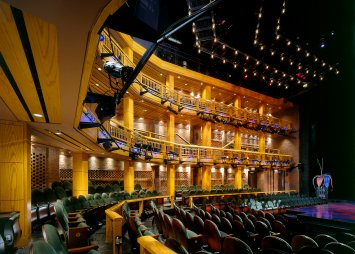Summary 
Designers and performers from Minneapolis in collaboration with a Chicago crew and cast. Quickly paced, with strong use of music and dance. Colorful and generally warm-hearted entertainment, marred by some inexplicably grotesque depictions of sexual and racial violence.

Design
Directed by Joe Dowling. Set by Frank Hallinan Flood. Costumes by Paul Tazewell. Lights by Kevin Adams. Sound by JR Conkllin. Compositions and musical direction by Keith Thomas. Choreography by Marc Robin.
Cast
Dunyon Davis (Puck/Philostrate), Timothy Gregory (Theseus/Oberon), Ellen Karas (Hipployta/Titania), David Lively (Egeus), Hermia (Elizabeth Ledo), Robert Kahn (Demetrius), Darrell Stokes (Lysander), McKinley Carter (Helena), William J. Norris (Quince), Richard Iglewski (Bottom), Jason Denuszek (Francis), Lynn Baber (Starvling), Ron Rains (Snout), Bradley Mott (Snug).
Analysis
Guest director Joe Dowling brings to Chicago Shakespeare Theater his vision of A Midsummer Night's Dream, importing some of his performers as well as a few design concepts from The Guthrie Theatre in Minneapolis. Puck begins the production with a wild dash through the audience, dressed only in a codpiece and a white-powdered fright wig, setting an energetic and borderline-bizarre tone for the rest of the show. The manic sprite bounds across the stage and back into the audience, imitating animals and playing with audience members, only returning to the stage when summoned by a backstage crew that dresses him in a formal black business suit for his role as the Philostrate, Puck behaving much like a rowdy child forced to sit in dressy grown-up clothes for a family portrait.
The stage then swarms with celebratory citizens in modern attire, scurrying to prepare for the arrival of the Duke and his soon-to-be bride. Theseus and Hippolyta enter through the audience to wild applause, smiling and waving like happy politicians about to deliver a down-home campaign speech. Theseus ceremoniously signs some political documents, somewhat distracted during Egeon's speech, and when he quite perfunctorily sides with Egeus against the romantic lovers, Hippolyta surprises him by shoving his hand away from her and storming off stage. Behind them upstage is a billowing royal blue curtain, the color matched by the gigantic blue flower with big tongue-like petals that sprouts from center stage in the Athenian forest.
Dowling's lightning-quick pace suits the multiple story threads and considerable slew of characters, and his stage bristles with movement and activity. The rude mechanicals - including a female Starvling, a boy-scout Flute, and director Quince consulting his laptop personal computer and distributing scripts with a cover photograph from Shakespeare in Love - are led by the self-important Bottom, strutting like an impresario with his jacket draped over his shoulders. Bottom leads the homespuns in rousing sing-alongs of "High Hopes" and "Some Enchanted Evening" - innocent, charming, unbelievably awful - while they rehearse their Pyramus and Thisby.
The woodland fairies wear a psychedelic 1960s-mod pink, with Titania wearing a wispy blue dress with side hoops and a see-through front. Oberon resembles a modern professional wrestler, rippling with muscle and strutting in a form-fitting leather costume with puffs and rolls at the wrists and ankles, and a long white-haired wig. The centerpiece blue flower dominates the stage, one of its tongue petals serving as Titania's bed. Dowling imbues the production, already warm-hearted and breathlessly fast-paced, with snippets of songs amid a bouncy musical score. Along with the colorful costuming, the score enhances the entertainment: the bursts of song range from old-time gospel to modern doo-wop to techno new age, with the First Fairy serving as both lead singer and lead dancer. Once Bottom is translated and Titania under a spell, the Fairies not only sing and dance, but they fly across the stage, swinging wildly from ropes.
Dowling's light entertainment darkens with the arrival of the young lovers into the fairy woodland. Less innocent than Bottom and the mechanicals, they seem to need to be taught an at times cruel lesson by Puck and the sprites. The lovers' clothes fly off almost upon their arrival in the forest, and they scatter into the woods just in their white undergarments. There are abrupt moments of cruelty - Puck's sexually assaulting the First Fairy is nothing less than attempted rape, and Oberon's amused fondling of Helena is a gross groping violation - and the head-scratchingly lewd and cruel behavior - far from flirtation or randy fun - includes the alarming image of a white-wigged white-man leader Oberon using a long bull-whip to lash at the black-skinned servant Puck. The audience squirms with discomfort through all three sequences, and onstage, both Titania and Hippolyta seem genuinely distressed with the men and leadership, although Titania becomes less angry at Oberon when she notices he has managed the reconcilement of all the human lovers, and Hippolyta capitulates to Theseus only as the multiple weddings are announced after her intervention (although Egeus must be restrained from pursuing Hermia with a riding crop).
The comically awful performance of Pyramus and Thisby concludes the production and considerably lightens the tone, returning to the warm-hearted nature of the early scenes but certainly not dispelling the gruesome images of sexual and political violence. Bottom and his actors proudly hum the theme music from Masterpiece Theatre upon their entrance before the Duke and Duchess and the newlyweds, and Bottom's Pyramus experiments with a wide variety of accents and tones to nice comic effect, as no one knows who or what he will sound like next. When he commits lovelorn suicide as Pyramus, Bottom shoots for the tragically dramatic moon, offing himself first with hara-kiri, then by a dram of poison, and finally a mock stab to the eye, finally expiring with a leg-kick and a cry of "Rosebud!"
This collaboration between talents from both the Guthrie Theatre and Chicago Shakespeare Theater concludes with the usual Bottom-led Bergomask dance finale segueing into a line-kicking Riverdance routine with the entire Athenian cast, then a new-age techno-pop free-style ballet with the dancing fairies whipping across the stage and ending the show with an exuberant dance through the audience.